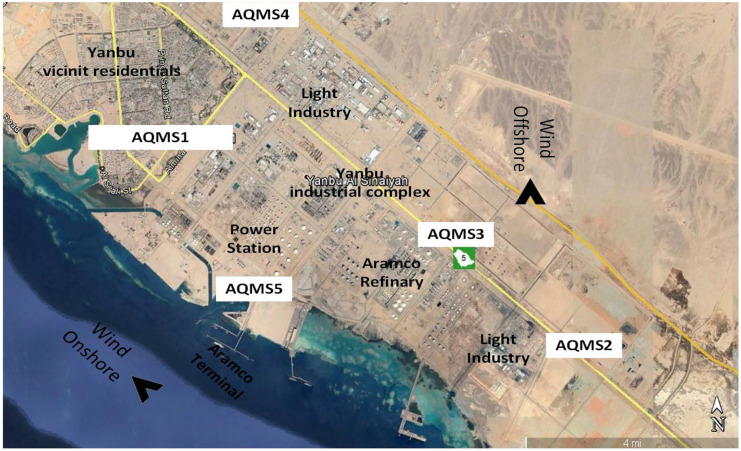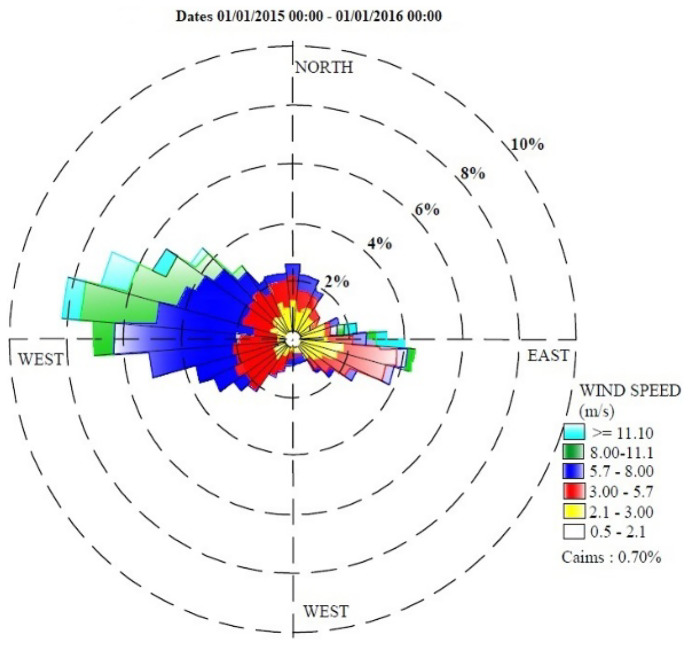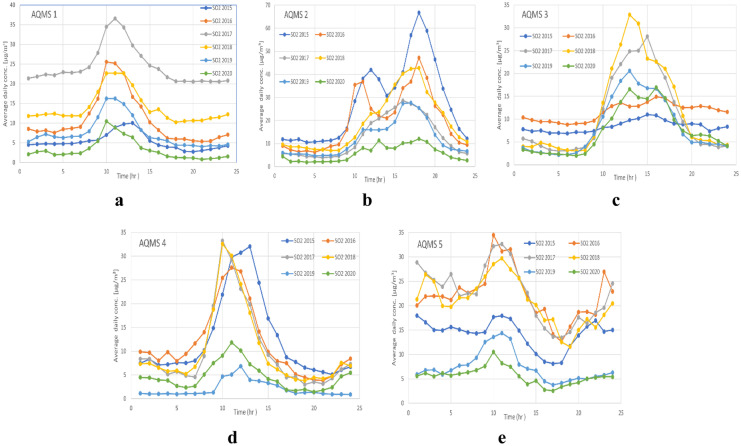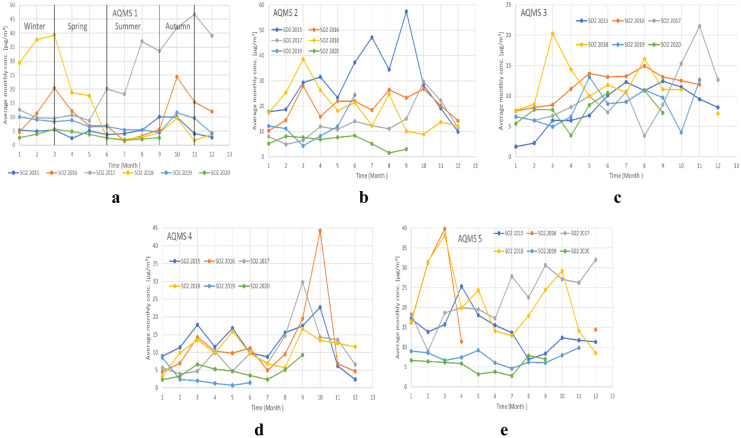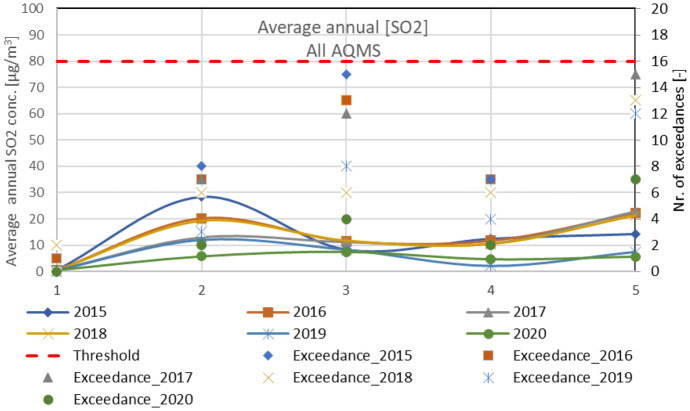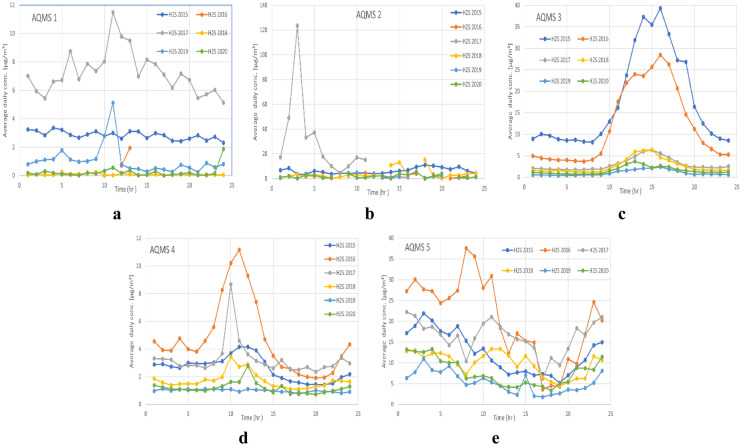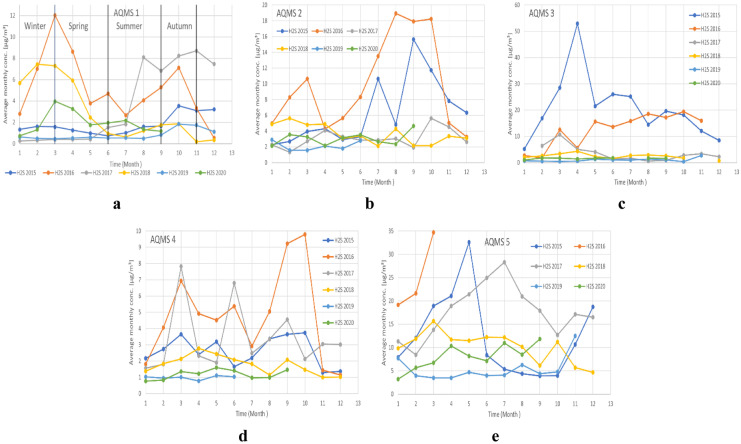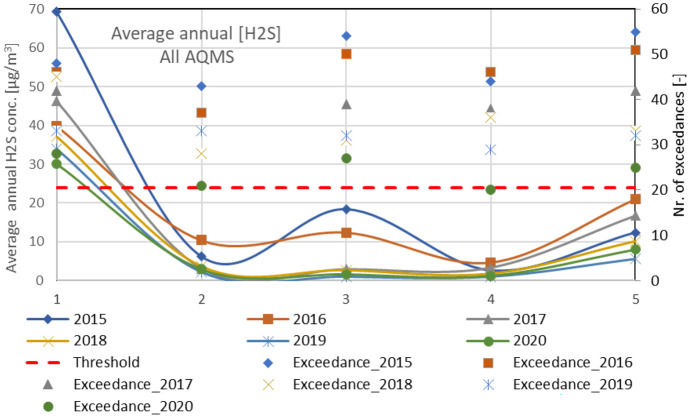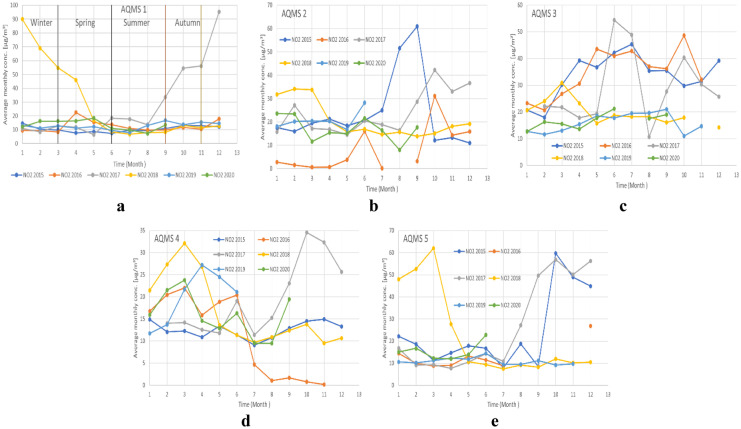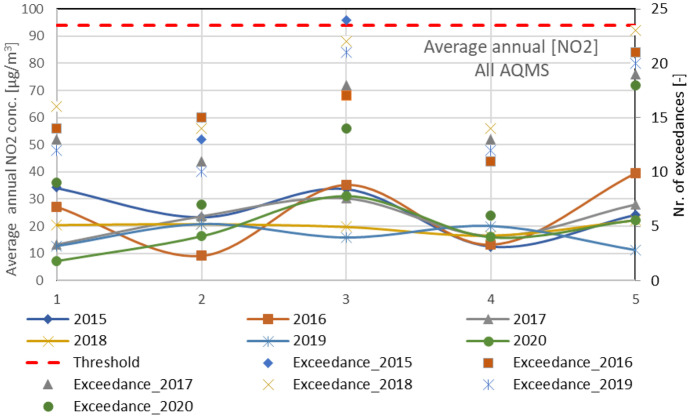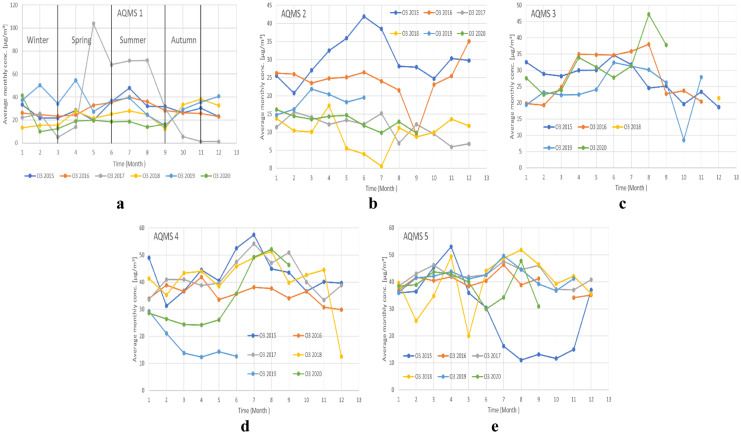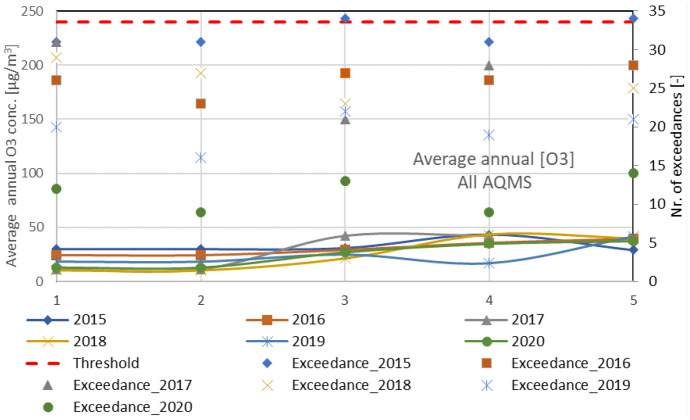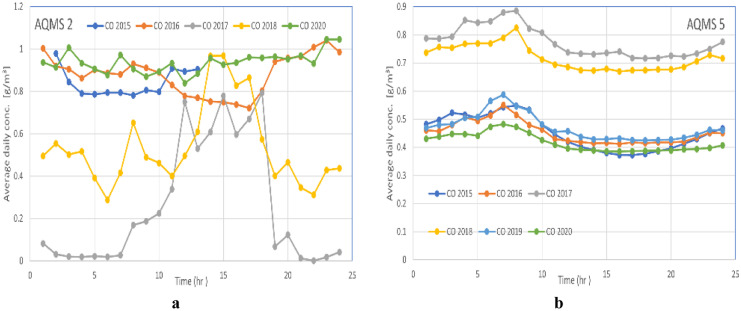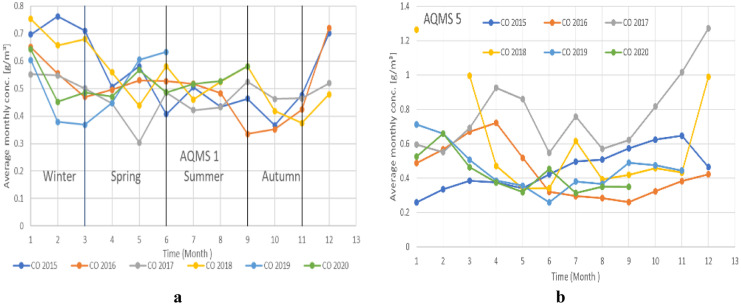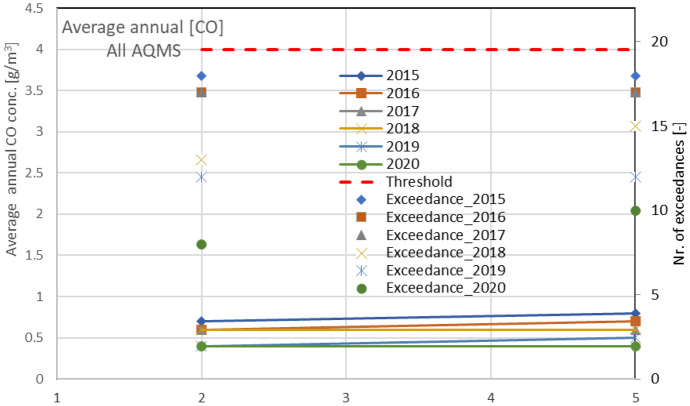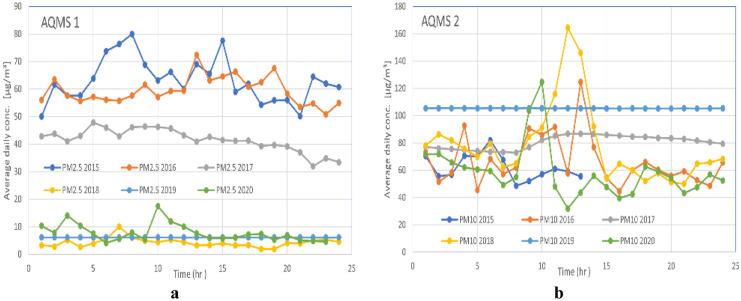Abstract
The objective of this study was to provide an appropriate evaluation of ambient air quality in industrial localities and the surrounding residential areas in its vicinity. Therefore, an assessment of gaseous emissions from industrial sectors was performed. For this purpose, concentrations were measured for SO2, H2S, NO2, O3, CO, PM2.5, and PM10 in five spatially diverse monitoring stations (AQMS) over different temporal intervals (daily, monthly, and annual) for the years 2015–2020. The impact on the environment and public health was evaluated through comparison with the corresponding regional and international standards. In the case study region, a substantial spatiotemporal variation was observed in the gaseous contaminants, due to the predominance of characterized meteorological parameters interfering with contributions from existing chemical facilities and anthropogenic activities. The exceedances for the investigated emissions were routinely violated the standard concentrations. According to AQI classifications, these violations were assigned to be within the acceptable limits for the gaseous emissions, moderately polluted for PM2.5, and unhealthy for sensitive groups for PM10. The proper distribution of the AQMSs within the industrial locality provides enough spatial and temporal observatory data, such that the exceedances were reduced with the subsequent years, hence appropriate evaluation of the relevant measurements revealed effective qualitative policies taken into action by authorities to maintain less accumulation of the gaseous emissions into ambient air beyond the harmful limits for public health and environment.
Keywords: Gaseous emissions, Yanbu industrial locality, Ambient air quality, Public health, Air pollution
Introduction
Nowadays, ambient air quality suffers a great challenge, that is, remediation of contaminated effluents produced from domestic, agricultural, and industrial activities due to gaseous emissions. To insure a more suitable outdoor air quality, specifically for industrial landscapes associated with vicinity residential areas, air pollution regulatory thresholds were correspondingly published to be regionally as well as internationally implemented to provide an assessment of health effects for serious health–harmful pollution levels in the industrial sectors. Parametric investigations were appealed by Aina et al. (2014) to extensively highlight findings on PM2.5 in several KSA cities within the years 2001–2010 (urbanized and industrialized) by means of mobile observatory stations, to highlight the trend of PM2.5 ground observations with which visualizations were combined for the purpose of data validation. This approach suffers from some obstacles especially on cloudy and dusty days. Meanwhile, Al-Azmi et al. (2009) compared measured NOx and SO2 inventories by static methods with short-term model predictions for 2 years in Kuwait power plants under current meteorological conditions, and promising results were only obtained with hourly measurements, leading to misleading long-term observations. In a relevant study, Al-Zboon et al. (2022) studied the prediction of ground levels of SO2, NO2, CO, and PM10 emissions from a thermal desalination plant in the western region of KSA with respect to reference observatory data, where the AERMOD Dispersion Model was applied to investigate the short-term health impact on an inhibited area restricted of 50 km by 50 km from the plant. Meanwhile, Alharbi et al. (2014) conducted their investigations on O3, CO, NO2, SO2, H2S, and PM10 within the period 1999–2004, obtained from 5 static AQMSs in King Abdulaziz City for Science and Technology (KACST) in Riyadh; subsequently, latterly PM10 and smog (metals and ions) were studied by Alharbi et al. (2015). Their investigations revealed that the concentration ratios of certain contaminants such as metalloids could be influential on the transportation scenarios for outdoor pollutants in residential areas. Al-Harbi et al. (2020) investigated the temporal variations for NO, NO2, SO2, and O3 by mobile measuring stations located in Ras Al-Khafji during the year 2013 for three monitoring areas (residential, industrial, and terminal). Also, a correlation study revealed that the concentrations of these contaminants clearly vary during the day and that the pattern and movement of air pollutants were significantly influenced by meteorological conditions. At observatory sites, non-buoyant ground-level sources, including home heating and traffic pollution, were regarded as the main sources of emissions. It should be focused on combination of different meteorological circumstances, within a massive industrial locality and intensive anthropogenic patterns on outdoor observations. Another factor to consider is the presence of a combination of different meteorological circumstances. A related study by Al-Jeelani (2014) was performed to examine spatiotemporal outdoor gaseous NO, NO2, NOx, O3, CO, SO2, CH4, TNMHCs (non-methane hydrocarbons), and other volatile organic compounds (VOCs) obtained from static observatory sites. However, within the Yanbu Industrial Complex, no significant variations were obtained for TNMHCs and CH4 as were obtained for the other contaminants. Therefore, long-term management programs were recommended for maintaining outdoor air quality in the proper condition for life and work.
For the special annual occasions of al-Fitr and al-Adha festivals, Ramadan, and the Hajj periods in KSA, when many cities in KSA are usually crowded with residents, visitors, and pilgrims for relatively short term durations of some days to few months, researchers extensively focused on the occurrence of outdoor emissions (Butenhoff et al., 2015; Dasari et al., 2020; Habeebullah, 2013; Hassan et al., 2013; Pasha & Alharbi, 2015; Shareef et al., 2018; Shareef et al., 2018). Anthropogenic activities have a particularly significant impact that coincides with seasonal phenomena like thermal boundary layer mixing on the widespread gaseous emissions with harmful limits in different KSA communities at a particular time. For long-term durations such as investigations by Hassan et al. (2019) and Khalil et al. (2016), it was revealed that the surface temperature expedited the photochemical process of O3 precursors to produce secondary emissions. Along with investigations on suspended particulate matters (Alharbi et al., 2015; Modaihsh et al., 2015; Pasha & Alharbi, 2015) when seasonal dusty winds have an influence on the buoyancy of contaminants to upper atmospheric layers as well as transportation to neighboring regions apart from emission sources, even more promising findings were highlighted in this domain for Egypt (Hindy & Abdelmaksoud, 2016), other sub-regions in the Middle East (Hariri et al., 2013; Uhkov et al., 2020), and Spain (Rovira et al., 2021).
In the literature, model data were used to predict the spatial and temporal variation in air pollutants for various air pollutants with a focus on potential risk assessment (Aina et al., 2014; Dasari et al., 2020; Munir et al., 2013; Munir et al., 2016; Uhkov et al., 2020). As such, studies have implied model predictions for outdoor contaminations, although they have shown apparent discrepancies between satellite-derived data and the in situ measurements. The reasons behind these discrepancies were attributed, from one side, to the exclusion of metrological factors like ground temperature and topography in changing outdoor gaseous levels, and on the other side, relative concentrations of relevant O3 precursors. In the study by Meng and Zhou (2020), reference air quality data (SO2, soot, and other industrial gas emissions) were acquired from reports by the National Bureau of Statistics, and a STIRPAT model was used to predict the air pollution emissions in the Beijing-Tianjin-Hebei region/China. In a pertinent study by Liang and Gong (2020), air pollution was investigated to evaluate the urban landscape effects of pollutants and their associations at the county level in China over the study period (2000–2014), where the largest urban growth is anticipated to occur. The annual mean PM2.5 concentration’s trends were determined using an empirical study and standard numerical methods, whereas Lee et al. (2014) used surface observational data of typical air pollutants (PM2.5 and SO2) collected from 14 static measuring sites in two mega-industrial complexes in Ulsan Province, Korea, which were simulated with the WRF-CALPUFF Model and the meteorological data were generated by CALMET software, to test the consistency of observational data with model predictions. In recent studies by Cichowicz and Dobrzański (2022a, b), the results of the OPA03 simulation were implemented to replicate actual field measurements obtained from sparsely located static and mobile observational sites near a heat and power plant and a communication route in Lodz, Poland. 3D maps were created using ArcGIS for the spatial distribution of the air contaminants (H2S, VOC, PM10, and PM2.5). These studies revealed that industrial gaseous emissions have always been critically important in determining shifts in outdoor emission levels. Generally, the economic growth in the case study area was suggested to slow down; this policy contributes to a steady boost in air quality and comparatively maintains long-term clean surrounding circumstances, conversely the influential consequences on the relevant economy. Alternately, several air dispersion models (like AERMOD, CALPUFF, ADMS, which are applying Gaussian, Lagrangian, and Eulerian approaches, respectively) are used to indirectly estimate the PM of various diameters based on the researches’ findings that there is a meaningful relation between outdoor air contaminants and PM. The meteorological, geography, effluent physical and chemical features, and other associated phenomena (co-variables) with air pollution must be considered by the air dispersion models for reliable reproductivity of observatory air quality measurements. On the other hand, these commercial air dispersion models have varying levels of complexity based on the approaches used, as well as long computation time intervals; suffer from significant deviation between their predicted results compared to observatory air quality data; and pose numerical constraints and fundamental limitation on the receptors’ number and model validity range.
To the best of the authors’ knowledge, no comprehensive study covers the impact of the Yanbu industrial city on ambient air quality; there were few contributions made for the behavioral assimilation of gaseous emissions in the Yanbu industrial complex and the surrounding area between 2015 and 2020 for the deduction of long-term management programs. The objective of the current investigation was to delineate the spatiotemporal distribution of outdoor flaring and air pollutants, namely, SO2, H2S, NO2, O3, CO, PM2.5, and PM10, within the Yanbu industrial complex and the associated residential areas. This could help to boost policies that provide an integrative assessment of relevant scientific information on gaseous emissions, collected from diverse monitoring AQMSs within the Yanbu industrial complex. Focusing on the basic criteria for air quality standards (the in situ concentration indicators, periodic intervals, and spatial distribution from the emissions source along with the meteorological circumstances), such criteria would evaluate the health protection afforded by the relevant outdoor air standards.
Methodology and materials
Case study area
Yanbu industrial locality, which has a current area of about 185 km2, is located about 350 km northwest of Jeddah on the Red Sea coast of Saudi Arabia. The remaining land consists of urban and desert regions, with industrial sectors making up about 18% of its total area. It contains many heavy industries and includes the footprints of huge manufacturers like Saudi Aramco and SABIK. The Yanbu industrial complex is also close to the main transportation harbor and includes tremendous petrochemical projects based on crude oil processing (mainly obtained from oil reservoirs in KSA’s eastern area), besides the third largest oil refinery in the world (with a production capacity of more than 140 million tons/ annum), large technical gases facilities with associated laboratories, wide container yards, huge goods warehouses, and two oversized pipelines extending over a distance of 1200 km connecting the Arabian Gulf and the Red Sea. Additionally, Yanbu’s geography contains significant amounts of mineral resources for iron ores, phosphate, gypsum, and copper (Alharbi et al., 2015; Al-Jeelani, 2014; Khalil et al., 2016; Shareef et al., 2018), which are suitable for other light and concrete industrial campuses. The Yanbu industrial complex has become the virtue of high-speed industrialization, and the vicinity residential city is properly served with wide highways, roads, and sufficient community factors that attract many work-powers from other countries, indicating the vitality of this fast-growing city. Consequently, Yanbu is also subject to increasing obstacle regarding environment and public health, and the running industrial activities of the large refining facilities, transportation harbor, and warehouses as well as large-scale city construction require a tremendous number of heavy vehicles and machines. Conversely, residential fills and rubbles due to densely populated areas and industrial wastes are sometimes not managed early. Therefore, the underground infrastructure as well the outdoor air quality needs to be secured and periodically monitored.
Source of data
A thematic strategy for the abatement of air emissions could be comprehensively evaluated by studying the spatiotemporal variation of outdoor air emissions, and this would imply conclusive evidence to enhance the continuous monitoring of ambient air pollutants through the long-term availability of in situ measurements. Implementing this approach would assist regional authorities to abate the consequences of air pollution. Moreso, regardless of anticipated changes in outdoor emissions, implementation and evaluation of control strategies could support sustainable development by allowing for reliable assessment of outdoor air quality, proper public health concerns for nearby residential areas within industrial infrastructure, and avoiding environmental deterioration (Almetwally et al., 2020; Kuklinska et al., 2015; Tsilingiridis et al., 2002; Weng et al., 2014). The Royal Commission at Yanbu (RCY) was founded as the custodial agency to plan and boost investments, mentor and manage the energy-intensive industries through integration between customers’ needs, investors’ interests, and industry with the community’s requirements for securing public health and a safe environment. In this context, a network of various AQMSs has been installed by the RCY and distributed in spatially diverse sites within the Yanbu industrial complex to monitor air pollution emissions. These sites are illustrated in Fig. 1.
Fig. 1.
Spatial AQMS’s distribution within the infrastructure of Yanbu industrial complex and vicinity residential
As the custodial agency, the RCY creates detailed health-related assessments of several air emissions, including SO2, H2S, NO2, O3, CO, PM2.5, and PM10, and these gaseous concentrations in outdoor air were continuously measured and recorded to essentially provide evidence regarding the burden of disease estimates caused by exposures to harmful air quality, according to regional and international guidelines, through monitoring and evaluation of gaseous emissions to empower the health sector to tackle outdoor air pollution. AQMS 1 is located to the south-east and south of Yanbu vicinity residential, respectively, while AQMS 4 is located to offshore downwind of Yanbu vicinity residential. AQMSs 1 and 4 mainly monitor the gaseous emissions routing from the Light-Industry campus (containing technical gases, Gypsum facility). AQMS 3 is located to the offshore downwind of the Aramco Refinery; in the other direction, AQMS 5 is located to the west-south direction of Aramco Refinery, onshore upwind of the power station and spatially close to Aramco terminals, while AQMS 2 is located to the east of a concrete industry including handling and production construction materials and a distance about 6 km south-east from Aramco Refinery. As summarized in Table 1, it was observed that the AQMSs were spread out over vast distances ranging from few kilometers from the nearby source to few tens of kilometers apart from each individual AQMS to ensure more comprehensive evaluation of the results. Furthermore, two locations were selected near the onshore zone, while the other three were within the offshore zone. The network was designed to ensure effective coverage of air quality in both the industrial and residential landscapes of Yanbu city.
Table 1.
Distance between individual AQMSs and nearby sources
| Distance (km) | AQMS1 | AQMS2 | AQMS3 | AQMS4 | AQMS5 | Nearby source (distance) |
|---|---|---|---|---|---|---|
| AQMS1 | – | 15 | 10.7 | 5 | 7 | Yanbu vicinity residential (2.6) |
| AQMS2 | 15 | – | 5 | 16.8 | 9.5 | Coment industry (1.3) |
| AQMS3 | 10.7 | 5 | – | 11.8 | 7.2 | Aramco Refinery (2.4) |
| AQMS4 | 5 | 16.8 | 11.8 | – | 12.3 | Light industry (3.8) |
| AQMS5 | 7 | 9.5 | 7.2 | 12.3 | – | Power station and Aramco Terminals (2.0) |
Surface measurements for outdoor emissions including SO2, H2S, NO2, O3, CO, PM2.5, and PM10 were obtained, and the gaseous concentrations in five outdoor air stations were collected from RCY reports over the years 2015–2020. In specific, AQMS 1–5 are capable of measuring and recording the investigated gaseous emissions; only AQMS 5 oversees CO measurements. Moreso, field PM2.5, and PM10 observations were performed in AQMS 1 and 2, respectively. The instrumentations used for measuring the gaseous pollutants’ concentrations were in situ close coupled multi-gas analyzers for real-time and simultaneous detection of gaseous emissions with integrated sample drying and data validation. UV fluorescence was used for detection of SO2/H2S analyzer, model AF-21 M, with maximum measuring figure of 2000 ± 1.0 µg/m3, where chemiluminescence NO2 analyzer of model AC-32 M has a maximum measuring domain of up to 2000 ± 0.5 µg/m3. For O3 analysis, a UV Photometric detection of model O3-42 M has maximum measuring range of 500 ± 0.5 µg/m3. NDIR CO-12 M analyzer model has CO detection up to 36.0 ± 0.02 g/m3. Beta Gauge analyzer was used for PM detection of particulate diameter within the range of 0.01–20 microns, with potential particulate account of 9.5 ± 35 × 104 PM2.5/cm3 and 1.7 ± 60 × 105 PM10/cm3. For detection of the meteorological parameters (wind speed and direction, temperature, and humidity), a meteorological station equipped with model Lastem was put into service. These instrumentations were delivered by Environment SA manufacturer (France).
Outdoor air quality standards
Harmful outdoor air pollutants are categorized as gaseous sulfur derivatives (like dioxide [SO2] and hydride [H2S]), nitrogen dioxides ([NO2], Ozone [O3], and carbon mono-oxide [CO]), and suspended particulate matters, which contaminate the anthropogenic and biogenic activities in the industrial regimes associated with population (Al-Zboon & Forton, 2019; Lou et al., 2019; Ramli et al., 2020; Sharma et al., 2020). A variety of industrial applications are responsible for SO2 and H2S emissions, which mainly originate from desulfurization of crude oils to immobilize the sulfur contents from end-fuel derivates to other components like SO2 and H2S; therefore, strict precautions must be met during the design and operation of Amine Washing units to reduce the emission of SO2, NO2, and CO into outdoor air (Al Rabadi, 2021; Al Rabadi et al., 2018; Heeres & Rineksa, 2014). High sulfur-containing fuels produce SO2 and H2S in the industrial applications of energy production from integrated smokestacks, while NO2 emissions are produced from denitrification processes of high nitrogen–containing fuel derivatives, thermal power plants, coal burning, and other industrial applications. Thus, NO2 could be produced by the chemical reaction of free atmospheric oxygen and nitrogen, which is achieved under specific circumstances during combustion (Munsif et al., 2021). Furthermore, CO emissions are associated with fuel-fired boilers and incomplete combustion source in a steep rate, while exposure to SO2, H2S, and CO can play a vital role in asthma, bronchial symptoms, lung inflammation, and reduced functionality. Conversely, photochemical reaction produces several secondary pollutants from O3 precursors like NO2, SO2, and CO (Hassan et al., 2019; Rovira et al., 2021), and elevated levels of atmospheric O3 have been considered a major concern in the damage to materials and manufactured goods or negative drawbacks on crops and vegetation (Munsif et al., 2021). Exposure to excessive atmospheric O3 is a major coincidence for asthma morbidity and mortality. Obviously, O3 obstacle is oft experienced in large cities near industrial sectors (Hassan et al., 2013, 2019; EEA, 2021; WHO, 2021), and Yanbu is analogous to many other cities in the Arabian Peninsula and worldwide suffering from urban smog problems (Alharbi et al., 2015; Weng et al., 2014). Atmospheric O3 may form hydroxyl radicals due to its radioactive force under specific conditions (Al-Harbi et al., 2020; Hassan et al., 2019). Meanwhile, NO2 and nitric oxide (NOx), SO2, and CO are usually major O3 precursors (Al-Azmi et al., 2009; Al-Jeelani, 2014; Butenhoff et al., 2015; Hassan et al., 2019; Shareef et al., 2018). The main parameters that steer O3 formation are the ratio of the relevant atmospheric precursors and the intensity of solar radiation. Another related emission is the particulate matter (PM), which is classified as a common indicator of outdoor air pollution. It is produced from a complex mixture of solid and liquid particulates constituted from organic and inorganic components and suspended in air (atmospheric aerosols, various oxides, carbonates, sulfate and nitrate salts, black carbon [CS], metalloids, and Sahara Desert or the so-called mineral dust) (Hariri et al., 2013). While particulates with a diameter of 10 microns or less, PM10, can penetrate and precipitate in respiratory vessels deep within the lungs, the more significant health-damaging particulates are those with a diameter of 2.5 microns or less, (PM2.5) (Algarni et al., 2021; Dasari et al., 2020; Habeebullah, 2013; Modaihsh et al., 2015; Munir et al., 2013, 2016; Sharma et al., 2020; Ukhov et al., 2020). As a synopsis, these studies suggest that particle size is the main factor for determining the residence time of particles in the atmosphere. As an illustration, fine particles with a diameter of 2.5 microns or less can typically remain in the air for some days (Aina et al., 2014). The atmospheric half-life of coarse particles, however, can range from some minutes to several hours (Munir et al., 2016), due to the gravitational settling and the temperature inversions between the upper and lower atmospheric layers. By monitoring air pollution levels in the relevant industrial sectors to ensure they are within regional and/or international thresholds, domestic authorities could contribute, to a great extent, in reducing the burden of diverse cardiovascular and respiratory diseases as well as cancers (Alharbi et al., 2014, 2015; Al-Harbi et al., 2020; Almetwally et al., 2020).
Thresholds for outdoor emissions are regulated by custodial agencies: international bodies such as World Health Organization (WHO), and the European Environment Agency (EEA), and regional bodies like the Royal Commission for Jubail and Yanbu (RCY). Air quality measurements are typically reported in terms of mean daily concentrations classified as exposure times of 1, 8, or 24 h and annual mean concentrations. The gaseous accumulations into atmosphere were attributed to tremendous demand for manufactured goods and products without giving any focus to their environmental influence on Yanbu industry locality. As listed in Table 2, air quality limitations were summarized according to regional guidelines such as the RCY as well as those by international associations, namely, WHO and EEA. Routine air quality measurements are typically described in units of micrograms per cubic meter of air volume for all the investigated air emissions, except for CO, where it is expressed in units of grams per cubic meter of air volume. Reported guideline values for SO2 according to RCY were 80 µg/m3 (annual mean), 367 µg/m3 (24-h mean), and a maximum of 734 µg/m3 (1-h mean), while a lower value of 40 µg/m3 (24-h mean) was reported by WHO. For H2S, some flexibility in the typical values was tabulated by the RCY as follows: 24 µg/m3 (24-h mean) and 200 µg/m3 (1-h mean) to be aligned with environmental issues and the investors’ interests in the petrochemical industry. According to RCY, NO2 guideline values are 94 μg/m3 (annual mean) and 658 μg/m3 (1-h mean), and since NO2 is the main source of nitrate aerosols that constitute atmospheric O3 and is linked to reduced lung functionality in residentials, strict limitations of 10 μg/m3 (annual mean) and 25 μg/m3 (24-h mean) were set by WHO, while moderate restrictions of 100 μg/m3 and 188 μg/m3 for annual and 24-h means, respectively, were reported by the EEA. For O3, conventional thresholds are 240 μg/m3 (8-h mean) and a maximum of 160 μg/m3 (1-h mean) based on peak season, which is defined as an average of daily maximum 1 h of mean O3 concentration. In this context, these O3 thresholds were considered for ground-level O3 and must not be confused with O3 content in the upper atmosphere. Ground-level O3 is produced by the photochemical reaction of O3 precursors like NO2, SO2, and CO. Therefore, significantly lower levels of O3 concentrations of 100 and 70 μg/m3 (8-h mean) have been established by the WHO and EEA, respectively; thus, excessive O3 in outdoor air may have a marked impact on public health and serious lung diseases for residents in Europe and the USA. Furthermore, due to the absence of regional guidelines for CO emissions in the outdoor air, the international regulations by WHO and EEA were followed for the current investigations. The WHO found CO limitations of 4 g/m3 for 24-h mean, while the EEA found 9 g/m3 and 35 g/m3 for 8-h and 1-h means, respectively. PM2.5 could be a constitutional fraction of PM10; therefore, restricted limitations on its concentration were tabulated in comparison with coarser PM10. In accordance to RCY, PM2.5 guidelines are 15 g/m3 and 65 μg/m3 for annual and 24-h means, respectively. For WHO, restricted levels are 5 and 15 μg/m3 of annual and 24-h means for a comprehensive assessment of PM2.5 outdoor air quality world widely. According to the EEA, moderate PM2.5 limits of 12 g/m3 and 35 μg/m3 for annual and 24-h means were reported; meanwhile, PM10 guidelines were stated by the regional RCY as 50 g/m3 and 150 μg/m3 for annual and 24-h means, respectively, and low levels were categorized by WHO as 15 g/m3 and 45 μg/m3 for annual and 24-h means, respectively, and the EEA set levels at 30 g/m3 and 150 μg/m3 for annual and 24-h means, respectively.
Table 2.
Ambient air quality thresholds
| Emission | RCYe | WHOe | EEAe | ||
|---|---|---|---|---|---|
| SO2 | [µg/m3] |
Annual mean 24-h meana 1-h meanc |
80 367 734 |
– 40 – |
– – 200 |
| H2S | [µg/m3] |
24-h meana 1-h meanc |
24 200 |
– – |
– – |
| NO2 | [µg/m3] |
Annual mean 24-h meana 1-h meanc |
94 – 658 |
10 25 – |
100 – 188 |
| O3 | [µg/m3] |
8-h meand 1-h meanc |
240 160 |
100 | 70 |
| CO | [g/m3] |
24-h meana 8-h meand 1-h meanc |
– – – |
4 – – |
– 9 35 |
| PM2.5 | [µg/m3] |
Annual mean 24-h meana |
15 65 |
5 15 |
12 35 |
| PM10 | [µg/m3] |
Annual mean 24-h meana |
50 150 |
15 45 |
30 150b |
aDefined as 99th percentile of the daily distribution of 24-h average concentrations
bDefined as 98th percentile of the daily distribution of 1-h average concentrations
cDefined as 99th percentile of the daily distribution of 1-h average concentrations
dDefined as daily maximum distributed over 8-h average concentration
eAccording to EEA, the time distribution is considered over a period of 3 years
The conversion factors were approximated according to the linear equation (EEA, 2021; WHO, 2021):
| 1 |
Based on the pollution levels related to health consequences, an air quality index (AQI) is used to convey to the public of how healthy or unhealthy the outdoor quality is on a particular day. The AQI is used to evaluate if the locality’s air quality is better or worse in vicinities remote from the observation/measuring location or to relate measured concentrations to probable health implications. For each air pollutant concentration, in details, a scale of exceedances’ account with respect to thresholds would justify the particular air quality. An AQI between 0 and 50 is deemed “good,” 51 to 100 is “moderately polluted,” 101 to 150 is “unhealthy for sensitive groups,” 151 and 300 is “unhealthy,” 201–300 is “very unhealthy,” and over 300 is “hazardous.”
Results and discussion
Meteorological data
Figure 2 shows the rose diagram depicting meteorological data from the Yanbu Department of Meteorology. It depicts the average wind speed and direction for the entire period of 12 months and the entire 24-h period over the year 2015. Accordingly, the variation in the meteorological parameters has been widely studied in the Yanbu region and surroundings (Al-Zboon et al., 2022; Khalil et al., 2016), and based on the hourly observations, it was stated that wind speed and direction in Yanbu industrial complex is largely affected by the climate of the Red sea. Low wind speed in the Yanbu region alters dispersion of pollutants, and air pollution lasts long in the city vicinity. Analysis of meteorological data revealed that the average wind speed remains between 2.1 m/s and 3.0 m/s (3.9–5.8) knots. The wind over the entire investigated case study area was classified as calm, or the so-called light breeze, and was unchanged for the purpose of air quality assessment. Furthermore, the meteorological data were presumed to be unchanged for the years 2015–2020, and the net wind direction was determined to be north within the offshore zone and north-west within the onshore zone (Red Sea’s eastern coasts).
Fig. 2.
Average wind speed and direction of Yanbu industrial complex and the residential area
Also, analogous findings were highlighted in related studies (Hariri et al., 2013; Hassan et al., 2013; Munir et al., 2016). The alternation of weather conditions on the east coast of the Red Sea has the following sequence: the spring season begins from early March till June, while summer term begins from June to August/September. From March to September, the hot month period is defined by an increase in temperature and ambient humidity, resulting in elevated coastal conditions (Aina et al., 2014; Al-Jeelani, 2014; Dasari et al., 2020; Habeebullah, 2013; Hariri et al., 2013; Hassan et al., 2013, 2019; Khalil et al., 2016). Afterward, the autumn season starts from the end of September to November when the weather changes from elevated coastal conditions to mild status of lower temperature and humidity rates. Due to the promotion of seawater evaporation, the maximum ground temperature during the warmest months could reach average highs around 45 °C with a relative humidity of more than 60%, while the mild status of the region is characterized by moderate temperatures of about 30 °C and relative humidity of 30%. In literature, the key climatic factors that potentially affect air quality are temperature, atmospheric visibility related to air humidity and cloud fraction, and horizontal wind speed and its direction. According to relevant studies by Al-Jeelani (2014) and Khalil et al. (2016), the variations in meteorological parameters in KSA’s coastal areas throughout the year may have a less pronounced contribution on the concentrations’ alternation of air pollutants than those caused by existing industrial infrastructures and other associated anthropogenic activities. According to these findings, the temporal and spatial fluctuation of air quality pollutants is related to the temperature effect derived from the temporal alternation of air pollutants’ concentrations between day and night as well as among different seasons.
Ambient air quality of gaseous pollutants
The average measurements of air emissions include the major outdoor air pollutants, SO2, H2S, NO2, O3, CO, PM2.5, and PM10 for the five AQMSs, and the time intervals of the relevant gaseous emissions were based on continuous diurnal and night measurements covering 24 h per day, over the calendar year duration of 12 months, and through the calendar year period from 2015 to 2020. These measurements intrinsically include the variation of day/night periods, with the influence of the temperature alternation between the hot and the cold months as well as the spatial distribution among the five foreseen AQMSs.
Daily SO2
The average daily SO2 measures for all AQMSs are illustrated in Fig. 3a–e, respectively, and as indicated, the detected concentrations SO2 were obtained for all foreseen temporal and spatial intervals. Obviously, a maximum peak in daily SO2 concentration profiles of around 35 μg/m3 is obtained during the midday periods between 09:00 A.M. and 03:00 P.M. (local Yanbu timing) for all years and spatial AQMSs, then, approaches lower limits during other day periods for the same relevant year around below 10.0 μg/m3, which is consistent with the findings by previous studies (Al-Harbi et al., 2020; Al-Zboon et al., 2022; Dasari et al., 2020; Hassan et al., 2019; Hindy & Abdelmaksoud, 2016; Khalil et al., 2016; Munir et al., 2013, 2016). The maximum peak is attributed for processing high sulfur content in fuel derivates, especially in the heavy fuel oil, and due to the high industrial activities within Yanbu industrial complex during the midday period. Therefore, other maximum daily SO2 concentrations were obtained to reach the values of 70.0 μg/m3 after the peak period around 6:00 P.M. (local Yanbu timing) for AQMS 2 in 2015. Principally, these higher SO2 measurements could be attributed to extraordinary industrial activities in the cement industry during that time interval. To pay more attention on this finding, an analysis of the field measurements is considered for the year 2015 and all AQMSs at 10:00 A.M. (local Yanbu timing) as an instance. Different figures were attained as 7.5 μg/m3 for AQMS1, 29.0 μg/m3 for AQMS2, 8.3 μg/m3 for AQMS3, 22.5 μg/m3 for AQM4, and 18.1 μg/m3 for AQMS5. This spatial variation is attributed to the nearby source from the relevant AQMS. More focus is to be drawn on the results of AQMS 5, before and after the daily peak measurements (9:00 AM till 3:00 PM); the lower limits achieved a high range of daily SO2 measurements between 15.0 and 25.0 μg/m3, especially for the periods of 2016 till 2018. This observation might be explained by a combination of covariables that could be responsible for such elevated measurements outside of peak times, since AQMS 5 is in the middle of the Yanbu industrial complex close to extremely active industrial facilities and a power plant. Even if the elevated SO2 concentration were obtained, the daily emissions were below the thresholds (Table 2). The obtained measurements indicated that SO2 is not an important contaminant of concern in the outdoor air of this specific location. Conversely, there is evidence for applying abatement policies to reduce the gaseous emissions toward the residential area.
Fig. 3.
Average daily measurements of SO2 concentrations within the period of 2015–2020: a for AQMS 1, b AQMS 2, c AQMS 3, d AQMS 4, and e AQMS 5
Monthly SO2
The average monthly SO2 measurements for all AQMSs are shown in Fig. 4a–e, respectively. Generally, it can be deduced from these diagrams that the temporal variation in SO2 mean concentrations differs between the cold (November to March) and hot months (April to October). During the hot months, lower emissions were recorded in the range of 10 to 20 μg/m3, while higher emissions were obtained during the cold months of the year in the range of 30 to 45 μg/m, which were even below the allowable limitations. In previous studies, the effect of ground temperature was distinguished from spatial distance for the emission source and other meteorological parameters such as humidity (Aleem, 2013; Munir et al., 2013; Al-Jeelani, 2014; Khalil et al., 2016; Ukhov et al., 2020). This temporal variation in monthly SO2 measurements was attributed to extraordinary energy requirements for heating the industrial and residential premises during cold months, and current findings particularly agree with those from the study by Al-Jeelani (2014). For illustration, the spatial distribution is deduced by comparing SO2 concentrations in October 2015 for all AQMSs. Figures attained as following 10.5 μg/m3 for AQMS1, 55.3 μg/m3 for AQMS2, 13.4 μg/m3 for AQMS3, 23.2 μg/m3 for AQMS4, and 13.7 μg/m3 for AQMS5. AQMS 2 recorded an elevated SO2 concentration due to huge demands in cement industry during this period, while records of AQMS 4 could be contributed to thermal demands for nearby light industry and Yanbu vicinity residential. According to the thresholds in Table 2, the salient result generally showed an obvious consistency in the average monthly SO2 emissions to be around the acceptable limits.
Fig. 4.
Average monthly measurements of SO2 concentrations within the period of 2015–2020: a for AQMS 1, b AQMS 2, c AQMS 3, d AQMS 4, and e AQMS 5
Annual SO2
Average annual SO2 measurements are summarized for the five monitoring AQMSs in Fig. 5. The annual trends were based on the continuous measurements using data collected over the entire period of 2015–2020, and the assessment (represented by the statistical criteria of mean and account of exceedances that SO2 measurements violate RCY limitations) was conducted to determine annual SO2 trends. Statistical data were highlighted to account for the number of exceedances when the gaseous measurements of air pollutants studied in current investigations only violate the RCY guidelines, considering the geographical location of the case study as well as the comprehensiveness of the RCY guidelines for all the investigated air pollutants in comparison to the restrictive WHO and EEA guidelines that are widely applied in Europe and over the Pacific regions. Except that average SO2 concentrations were obtained, e.g., for AQMS 2 as 28.4 μg/m3 in 2015, 20.2 μg/m3 in 2016, 19.5 μg/m3 in 2017, 18.9 μg/m3 in 2018, 15.6 μg/m3 in 2019, and 5.8 μg/m3 in 2020, respectively. The obtained trend for annual SO2 mean concentration for all the monitoring AQMSs showed that there is a decrease in the annual SO2 concentration over the investigated periods from 2015 to 2020. Some exceedances were routinely recorded behind the relevant tabulated guidelines by the RCY (80 μg/m3). Extensively, few exceedances were recorded in AQMS 2 such that 8 violations were recorded in 2015, 7 in 2016 and 2017, 6 in 2018, 3 in 2019, and 2 in 2020. Obviously, a pronounced decrease in annual SO2 mean concentration was generally observed through the period from 2015 to the beginning of the first COVID-19 lockdown in 2020. Generally, reduced accounts were documented of the annual exceedances for SO2 measurements during the period from 2015 to 2020 for AQMS 2–5, respectively. By accounting for the number of violations of annual SO2 concentration for all AQMSs, which is below 50 on AQI scale, the pollution levels related to health consequences are deemed as good. Whereas potential health hazards due to the inhalation of SO2 gas could lead to nose and throat infection, bronchitis, and eyes irritation, high dosages or prolonged exposure to SO2 might impact a serious lung malfunction, eventually leading to death. Therefore, symptoms may vary according to exposure time and the residential’s sensitivity, and in most cases, the symptoms appear within short periods of 10–15 min after exposure. According to EEA (2021), WHO (2021), and RCY (2022), it has been reported that at up to a concentration of 100 µg/m3, the bronchi would be significantly affected, while higher concentrations of up to 400 µg/m3 reduce lung functionality. Considering the reduced accounts of the annual exceedances for SO2 measurements in spatially distinct locations, it was concluded that the Yanbu industrial complex was subject to lower consequence levels of SO2 accumulation without significant threats to the environment and public health.
Fig. 5.
Spatial average annual SO2 measurements for AQMSs during 2015–2020, with account of exceedances per annum that SO2 measurements violate RCY limitations
Daily H2S
The trends of H2S daily measurements for all AQMSs are shown in Fig. 6a–e. In general, a peak was observed for all AQMSs between 8:00 A.M. and 3:00 P.M. (local Yanbu timing), with a maximum H2S concentration of 12.4 μg/m3, and a minimum H2S concentration of ≤5.0 μg/m3 was recorded from early morning to evening for all AQMSs. This trend can be mainly attributed to anthropogenic and industrial activities during the day. Nonetheless, the following exceptions were also observed: a maximum concentration of approximately 122.0 μg/m3 for AQMS 2 in 2017, 40.0 μg/m3 for AQMS 3 in 2015, and 28.0 μg/m3 in 2016, although this peak was recorded around 8:00 P.M. (local Yanbu timing), which was attributed to industrial activities during this period. Despite the maximum concentration obtained for AQMS 2 in 2017, there were no exceedances according to the RCY limitations of 200 μg/m3 (1 h mean). Additionally, the spatial distribution for all AQMS 2–5 can be highlighted by analyzing the daily H2S concentration at 08:00 A.M. (local Yanbu time) for e.g. 2017, where figures were found as 8.1 μg/m3, 15.7 μg/m3, 3.8 μg/m3, 3.2 μg/m3, and 16.2 μg/m3, respectively, different concentrations were obviously obtained. Additionally, the trend for AQMS 5 varied, where a peak (38.0 μg/m3) was observed between 8:00 A.M. and 11:00 A.M. (local Yanbu timing), recording some violations in the daily concentration with respect to threshold set by RCY (24 μg/m3). However, the daily H2S concentration dropped below the threshold set by RCY for the rest of the day. This could be attributed to the geographical location of AQMS 5 that was located at the center of on-shore, industrial, and anthropogenic activities. The daily H2S concentration varies within the acceptable limit and emphasized the efficient policies applied to abate the gaseous emissions from the smokestacks of the manufacturing facilities neighboring AQMS 5.
Fig. 6.
Average daily measurements of H2S concentrations during 2015–2020 for a AQMS 1, b AQMS 2, c AQMS 3, d AQMS 4, and e AQMS 5
Monthly H2S
The experimental data for the monthly H2S concentrations for all AQMSs are presented in Fig. 7a–e. In situ H2S emissions revealed a pattern, where emissions increased during the spring and then decreased during the hot months. In contrast, monthly H2S concentrations peaked during autumn, and low concentrations were recorded during the winter season. Even with pertinent studies carried out in other urban environments in the Gulf region (Alharbi et al., 2014), the Mediterranean region in Egypt (Hindy & Abdelmaksoud, 2016), Spain (Rovira et al., 2021), and Greece (Tsilingiridis et al., 2002), the lowest monthly H2S concentrations recorded in winter may be related to the absence of dusty winds, which were analogous in other urban Saudi cities such as NEOM (Dasari et al., 2020). Contrary to the findings of this study, the buildup in monthly H2S concentrations was attributed to increased demands for fuel derivatives for heating during winters. By comparing the present results with the thresholds stated by RCY, we concluded that Yanbu city was subjected to unharmful levels of H2S during 2015–2020. Apart from natural phenomena, such as dusty winds in summer, the turbulence of the boundary layer was less in springs and winters and trapped the pollutants near the ground because of fewer temperature inversions between the upper and lower atmospheric layers. During the summer months, in contrast, thermal heating at the ground level promoted turbulence and the mixing of atmospheric layers, which, consequently, enhanced buoyancy and the migration of outdoor pollutants toward upper atmospheric layers. In addition, this suggested that H2S emissions were adequately regulated through proper distribution of monitoring AQMSs over the Yanbu industrial complex, considering that H2S emissions were a genuine environmental hazard that degrade the quality of life and endanger public health in both residential and industrial areas.
Fig. 7.
Average monthly measurements of H2S concentrations during 2015–2020 for a AQMS 1, b AQMS 2, c AQMS 3, d AQMS 4, and e AQMS 5
Annual H2S
Average annual H2S concentrations are summarized for the five monitoring AQMSs in Fig. 8. Annual trends in H2S concentration were based on continuous measurements using the data collected during 2015–2020, and the assessment, represented by the statistical parameters of mean and account of exceedances, indicated that NO2 measurements violated RCY limitations. The average annual H2S concentrations decreased from 69.4 μg/m3 in 2015 to 30.1 μg/m3 in 2020 for AQMS 1, from 6.2 μg/m3 in 2016 to < 3.0 μg/m3 in 2020 for AQMS 2, from 18.4 μg/m3 in 2015 to 1.6 μg/m3 in 2020 for AQMS 3, from 2.6 μg/m3 in 2015 to < 1.2 μg/m3 in 2020 for AQMS 4, and from 12.4 μg/m3 in 2015 to < 8.0 μg·/m3 in 2020 for AQMS 5. This alternating annual H2S trend might be explained by the differences in the aerosol size in the source regions. These findings have been verified for other urban environments in the east coasts’ region of the Red Sea (Aleem, 2013; Alharbi et al., 2014; Dasari et al., 2020; Hariri et al., 2013; Khalil et al., 2016). The main anthropogenic cause of H2S emissions over AQMSs 1, 2, and 4 was vehicular traffic density, as well as light and cement industries. Meanwhile, for AQMS 3 and 5, the trend in annual H2S emissions can be explained by the massive energy demands of oil processing facilities for manufacturing fuel–based hydrocarbon derivatives. According to regulations, H2S exhibits a wide range of potential human health impacts, with a gradual increase observed in the severity of symptoms, which depends on exposure periods. Exposure to 100 µg/m3 H2S for 15–30 min alters breathing and causes drowsiness, which could be fatal after 48 h, and 200 µg/m3 of H2S could cause conjunctivitis and respiratory tract irritation, with pulmonary edema occurring from prolonged exposure, resulting in death within 30–60 min. Eventually, we observed violations to the RCY guidelines in annual H2S measurements. Additionally, 48 and 28 exceedances were recorded in 2015 and 2020, respectively, for AQMS 1; 43 and 21 exceedances were recorded in 2015 and 2020, respectively, for AQMS 2; 54 and 27 exceedances were recorded in 2015 and 2020, respectively, for AQMS 3; 44 and 20 exceedances were recorded in 2015 and 2020, respectively, for AQMS 4; and 55 and 22 exceedances were recorded in 2015 and 2020, respectively, for AQMS 5. By accounting for the number of violations of annual H2S concentration for all AQMSs, which is in general below 50 on AQI scale, the pollution levels related to health consequences are deemed as good. An exception was noticed where the number of exceedances was recorded 55 for AQMS 5; hence, AQI was considered as moderately polluted. These violations were synchronizing the raise in production capacities in the nearby chemical facilities in 2015. In this context, a suitable program for limiting the detrimental effects of pollution on health during production scenarios with maximum capacities in the neighboring facilities could be recommended based on the current findings. In particular, the RCY received the results for excessive execution of the air quality improvement strategy at the industrial and nearby residential areas for this purpose.
Fig. 8.
Spatial average annual H2S measurements for AQMSs during 2015–2020, with account of exceedances per annum that H2S measurements violate RCY limitations
Daily NO2
The daily profiles of NO2 concentrations for all AQMSs are shown in Fig. 9a–e. The daily NO2 concentration trend exhibited two peaks; the first observed around 8:00 A.M. (local Yanbu timing), reflecting a reduction in NO2 concentrations to reach a minimum around 3:00 P.M. (local Yanbu timing). After midday, the profiles were reestablished with a second peak for evenings and a stable concentration during nights. This trend was symmetric with the findings of previous studies (Al-Azmi et al., 2009; Alharbi et al., 2014; Al-Jeelani, 2014; Butenhoff et al., 2015; Hassan et al., 2019; Shareef et al., 2018; Tsilingiridis et al., 2002). These concentrations highlighted the influence of photochemical processes favored by solar radiation for O3 formation within the lower atmospheric layers. The photochemical reaction occurs in the following sequence: NO2 in the outdoor air is broken down by sunlight to generate NO and free oxygen atoms, which then react rapidly with ambient O2 to form O3. This phase was responsible for the decrease in daily NO2 concentrations during midday. In contrast, O3 decomposition starts with its reaction with NO to complete the cycle, and hence, NO2 is further generated during the rest of the day. This phase was accountable for the second peak in the daily profile of NO2 concentration. The lowest levels were recorded during midday around 3:00 P.M. (local Yanbu timing), establishing a range of NO2 daily concentrations between 5.0 and 10.0 µg/m3 for AQMS 1; 5.0 and 15.0 µg/m3 for AQMS 2; 28.0 and 30.0 µg/m3 for 2015–2017 and 12.0 and 17.0 µg/m3 for 2018–2020 for AQMS 3; 5.0 and 8.0 µg/m3 for all years for AQMS 4, except for 2019 that exhibited a minimum concentration of 15 µg/m3; and 5.0 and 15.0 µg/m3 for AQMS 5. The attained minimum was associated with the consumption of daily NO2 deposition processes, which brought daily NO2 concentrations to acceptable limits. Moreover, the minimum daily NO2 concentration at AQMS 3 ranged between 28.0 and 30.0 µg/m3 for the years 2015–2017, compared to the range of 12.0–17.0 µg/m3 for the years 2018–2020. This ensured low NO2 emissions in accordance with the RCY and EEA guidelines.
Fig. 9.
Average daily NO2 concentrations during 2015–2020 for a AQMS 1, b AQMS 2, c AQMS 3, d AQMS 4, and e AQMS 5
Monthly NO2
Figure 10a–e illustrate the monthly variation of NO2 concentrations for all AQMSs. Similar to previous studies (Hariri et al., 2013; Hassan et al., 2013; Hassan et al., 2019; Al-Jeelani, 2014; Hindi & Abdelmaksoud, 2016; Khalil et al., 2016; Dasari et al., 2020), there was a direct association between meteorological conditions, such as ambient temperature, and in situ NO2 concentrations. The low monthly NO2 concentrations during midday might be due to intense dilution conditions under the influence of temperature inversions. Furthermore, elevated temperatures and dense solar radiation during midday promoted photochemical reactions, which enhanced the chemical degradation of NO2, reducing their in situ accumulation. Nonetheless, the following trend was noticed: maxima were recorded during winter 2018 for AQMS 1, with concentrations reaching >90 µg/m3; for AQMS 2 with 35.4 µg/m3; for AQMS 30.5 µg/m3; for AQMS 4 32.5 µg/m3; and for AQMS 5 60.3 µg/m3. The trend of monthly NO2 concentrations was attributed to cross-acting phenomena, such as the alternation in thermal boundary-layer mixing and anthropogenic emissions, in combination with geographical location from the source regions.
Fig. 10.
Average monthly NO2 concentrations during 2015–2020 for a AQMS 1, b AQMS 2, c AQMS 3, d AQMS 4, and e AQMS 5
Annual NO2
Average annual NO2 measurements for the five AQMSs are summarized in Fig. 11. The annual NO2 trends were based on the continuous measurements over the entire period of 2015–2020, and the assessment, represented by the statistical parameters of mean, and account of exceedances that NO2 measurements violated the RCY limitations, was used to determine annual NO2 trends. The findings of the spatiotemporal analysis for NO2 emissions revealed a general trend, whereby the concentrations fluctuate with each successive year and are kept below the thresholds. This trend focused on the effective control of the anthropogenic and industrial activities in the Yanbu industrial complex. The basic human sources for NO2 emissions were automotive emissions, in addition to emissions from smokestacks in chemical and oil processing facilities. Yanbu is also characterized by the highest number of vehicle proprietorships, due to absence of public transportation such as buses, trains, and street-trams. In addition, Yanbu’s sprawling residential areas, apart from the industrial complex, have massively contributed to outdoor air emissions through daily driving routes from/to work. This fact has been highlighted by previous studies (Alharbi et al., 2014; Al-Jeelani, 2014; Butenhoff et al., 2015; Shareef et al., 2018), where it was noted that NO2 concentrations in populated suburbs might result from vehicle emissions and urban activities, whereas industrial emissions might be caused by hydrocarbon production and processing activities.
Fig. 11.
Spatial average annual NO2 measurements for AQMSs during 2015–2020, with account of exceedances per annum that NO2 measurements violate RCY limitations
Furthermore, the spatiotemporal variability in NO2 concentration was combined with the alternation of in situ measurements of other pollutants, such as atmospheric O3, due to photochemical reactions and deposition. Owing to non-linear O3 precursor alliance, a mitigation plan for atmospheric precursors, such as NO2, might not abate O3 formation in the case of abundant solar radiation. Moreover, a potential increase might occur in O3 and NO2 concentrations in the background, which might be highly dependent on the surrounding meteorology and local conditions, as has been stated by several studies (Khalil et al., 2016; Munir et al., 2013, 2016; Rovira et al., 2021). For an effective mitigation plan, a comprehensiveness O3–NO2 relationship along with the meteorological measurements is required. Additionally, potential human health impacts of NO2 exposure must be further addressed; short-term exposure for a period of 1 h below 200 µg/m3 is associated with adverse health effects such as bronchi resistance, forced expiratory volume, and carbachol reactivity. High NO2 concentrations could cause serious functional issues in patients with chronic obstructive pulmonary disease. Additionally, long-term exposure for a period of 24 h below 40 µg/m3 is associated with respiratory symptoms/diseases, hospital admissions, otitis media, and even mortality. Regularly, exceedances were accomplished under circumstances that were acceptable. Although annual in situ NO2 measurements were illuminated by sustainable management policies, it must be emphasized that exceedances were still attained. Despite this, the AQI was deemed to be good.
Daily O3
Th spatiotemporal variations in daily O3 concentrations for all AQMSs are described in Fig. 12a–e. The daily O3 measurements (over 24 h) indicated lower concentrations during the night and early morning. From 9:00A.M. (local Yanbu time) onward, O3 concentrations would peak until midday. Afterward, minimal concentrations were recorded at the end of day, as well as during evenings and nights. This trend could be explained by high solar intensity during midday. As shown in Fig. 9a–e, the daily O3 profiles aligned with the profiles of daily NO2 concentrations, with the first peak synchronously obtained for NO2 emissions at the time when low daily O3 concentrations were recorded. Meanwhile, when daily NO2 concentrations were low, we noticed high O3 concentration. These findings indicate that the variability in daily O3 concentrations can be explained by a negative linear dependence on O3 precursor’s concentrations, which has been addressed in studies conducted by Tsilingiridis et al. (2002), Habeebullah (2013), Munir et al. (2013), Munir et al. (2016), Al-Jeelani (2014), Butenhoff et al. (2015), Shareef et al. (2018), Hassan et al. (2013), Hassan et al. (2019), and Al-Harbi et al. (2020). As deduced from these studies, NO2 and volatile organic compounds (VOCs) combine in the presence of sunlight to produce the reactive gas O3. There are many different sources that release these contaminants, such as industrial emissions, automobile exhaust, and more. When there is intense solar radiation and it is warmer outside, the O3 amount in the surrounding air is usually at highest level. For illustration, the daily O3 concentration for 2019 at midday was recorded as the following 58.2 µg/m3, 33.5 µg/m3, 43.6 µg/m3, 29.8 µg/m3, and 57.8 µg/m3 for AQMS 2–5, respectively. This spatial variation in the daily O3 concentration is attributed to topographical features, as well as the influence of meteorological parameters, such as humidity and thermal boundary layer mixing, on daily O3 concentrations. Evaluation of the outdoor air quality of the study area according to the regulatory standards of EEA for the protection of human health of 70.0 µg/m3 confirmed that only on some occasions, in situ O3 levels violated these regulations, but otherwise, regulated limitations of the RCY and WHO guidelines were met. The local authorities may implement measures to lessen NO2 and VOC emissions during daily peak periods, such as restricting vehicle use or cutting back on industrial activity during peak hours. There are numerous actions people can be taken in addition to abovementioned ones to lower the daily O3 concentration in Yanbu Industrial City. Use low-VOC products in the house, take public transportation instead of driving alone, and turn off lights and devices when not in use to save energy.
Fig. 12.
Average daily O3 concentrations during 2015–2020 for a AQMS 1, b AQMS 2, c AQMS 3, d AQMS 4, and e AQMS 5
Monthly O3
Figure 13a–e illustrate average monthly O3 measurements for all AQMSs during 2015–2020. The climatological status was considered for the Yanbu industrial complex and the surrounding residential areas, with the alternation of the cold and warm months throughout the year. The monthly O3 concentrations vary monthly based on several variables, such as climate, emissions from nearby sources, and seasonal variations. The monthly concentrations are usually higher during the summer when there is more sunlight and temperatures are higher. This is because, under these circumstances, the chemical reactions that produce O3 happen more rapidly. However, other co-variables like wind patterns and the location of emission sources can also contribute in the alternation of the monthly O3 concentration. For clarification, the monthly O3 concentrations revealed that there were slight increase in outdoor O3 levels that established a peak; 105.8 μg/m3 during May 2017 for AQMS 1; 42.5 μg/m3 during June 2015 for AQMS 2; 37.9 μg/m3 during August 2016 for AQMS 3; 58.2 μg/m3 during July 2015 for AQMS 4; and 54.3 μg/m3 during April 2015 for AQMS 5. Due to unreliability of the experimental data, monthly O3 concentrations were not considered for AQMS 3 during 2017. From 2015 to 2020, monthly O3 concentrations were highest during the hot months (March to September). In contrast, lower O3 levels were recorded during the cold months (October to February). These findings indicated the role of outdoor temperature, a vital meteorological parameter, in variations in O3 concentrations in outdoor air because of its influence on photochemical processes that favored O3 formation and accumulation within the lower atmosphere during midday. This finding was confirmed by previous studies (Habeebullah, 2013; Hassan et al., 2013, 2019). However, few differences in monthly O3 concentrations were noticed with respect to the general behavior for all AQMSs, except that for AQMS 5, which could be attributed to the enormous industrial activities within oil processing facilities and huge exportation through nearby terminals during the hot months of the year. Nonetheless, on certain occasions, exceedances in monthly O3 concentrations occurred in accordance with the RCY, WHO, and EEA guidelines. Despite the Yanbu industrial complex making progress in recent years in terms of reducing emissions and improving air quality, there is still work to be done to guarantee that arrangements are made to ensure that the monthly O3 concentration and other pollutants remain within acceptable boundaries for the health and well-being of inhabitants as well as the environment. Monitoring air quality and taking action to reduce emissions can help the community progress toward a healthier and cleaner future.
Fig. 13.
Average monthly O3 concentrations during 2015–2020 for a AQMS 1, b AQMS 2, c AQMS 3, d AQMS 4, and e AQMS 5
Annual O3
Average annual O3 measurements are summarized for all AQMSs in Fig. 14. Annual O3 profiles were based on continuous measurements collected over the period 2015–2020, and the assessment, represented by the statistical parameters of mean, and account of exceedances that O3 measurements violated the RCY limitations, was used to assess annual O3 profiles and examine the outdoor air quality. The spatiotemporal analysis of O3 emissions revealed a trend in which these concentrations appeared to change with each year: 30.3 µg/m3 in 2015 to 12.8 µg/m3 in 2020 for AQMS 1; 30.3 µg/m3 in 2015 to 12.8 µg/m3 in 2020 for AQMS 2; 31.1 µg/m3 in 2015 to 27.1 µg/m3 in 2020 for AQMS 3; 43.1 µg/m3 in 2015 to 35 µg/m3 in 2020 for AQMS 4; and 29.3 µg/m3 in 2015 to 37.5 µg/m3 in 2020 for AQMS 5. This trend could be attributed to effective regulations on anthropogenic and industrial activities in the Yanbu complex with residential areas. According to previous findings (Butenhoff et al., 2015; Khalil et al., 2016; Shareef et al., 2018), outdoor temperature, as the dominant meteorological parameter, was responsible for O3 formation and accumulation in the lower atmosphere as it enhanced photochemical reactions and air convective currents at the ground level. The study’s findings indicate that Yanbu Industrial City’s yearly ozone concentration should raise concerns because it may be harmful to people’s health, particularly respiratory condition sufferers. For the potential health impacts, it has been reported up to O3 concentration of 100 μg/m3, and mortality increases significantly at an exposure time of 8 h. Low concentrations might lead to irritation in the respiratory system, breathing restrictions, and massive lung malfunction, and eventually, permanent damage to the lungs. Based on current assessment, some violations of the tabulated guidelines were observed over the study period, in addition to a trend where low O3 exceedances were recorded with each successive year. Most of the in situ measurements were attained below the threshold of 240 µg/m3 over 8-h exposure periods. During congestion periods, O3 concentrations in the case study area might reach elevated figures. Because the percentage of exceedances was under 50, the AQI was regarded as being good. However, O3 concentrations in the case study area could achieve higher figures during periods of congestion. Reducing emissions from automobile exhaust and industrial smokestacks is such recommendation forwarded to the RCY to overcome this obstacle.
Fig. 14.
Spatial average annual O3 measurements for AQMSs during 2015–2020, with account of exceedances per annum that O3 measurements violate RCY limitations
Daily CO
The average CO daily measurements are diagrammed in Fig. 15a, b, respectively, through the years 2015–2020 for the investigated AQMSs 2 and 5. While, the experimental results for the other investigated monitoring AQMSs 1, 3, and 4 were unreliable and were excluded from the current assessment. As highlighted, CO accumulations were produced directly from smokestacks because of the incomplete combustion of hydrocarbon derivatives. Consequently, power plants and refineries were classified as rich sources of CO emissions according to WHO and EEA tabulations. According to related studies (Butenhoff et al., 2015; Dasari et al., 2020; Habeebullah, 2013; Munir et al., 2013, 2016), CO directly contributes to photolysis reaction as an O3 precursor, reacting with ambient O2 to form O3 and carbon dioxide as a by-product, aided by dense solar radiation. Conversely, CO participates in oxidation–reduction reaction for ambient humidity and reacts with the NO contaminant in lower atmosphere layers to form NO2, which in turn contributes as an O3 precursor through a photochemical reaction. Consequently, photolysis and oxidation–reduction reactions were stimulated at elevated temperatures because they could occur simultaneously. A maximum level in CO concentration was recorded with the value of 1.05 g/m3 for AQMS 2 and 0.9 g/m3 for AQMS 5. It was observed that the daily CO concentrations for AQMS 2 were a little erratic, while clear trends were attained in CO concentrations for AQMS 5, which obviously peaked around 8:00 A.M. (Yanbu local time). This interval normally synchronizes with the beginning of an ordinary labor day in Yanbu, as well as with the peaks in daily NO2 concentrations. This could be evidence of the occurrence of oxidation–reduction reaction for ambient humidity. Furthermore, almost unchanged CO levels in the ambient were attained for the rest of the day. This finding was highlighted in previous studies by Munir et al. (2013) and Munir et al. (2016). Based on their findings, a combination of co-variables could contribute to almost unchanged CO levels beyond the peak periods. Climate, traffic patterns, and the manufacturing processes deployed by the nonstop industrial facilities contribute such covariables with a footprint on CO emissions. Minimizing your exposure to CO is crucial for your health, so as to avoid congested regions during rush hour, maintain the appliances and heating system appropriately, and heed any local air quality advisories or warnings.
Fig. 15.
Average daily measurements of CO concentrations in the period 2015–2020: a for AQMS 2 and b AQMS 5
Monthly CO
The monthly variation of CO concentrations is depicted in Fig. 16a, b for monitoring AQMSs 2 and 5 over the period 2015–2020. The experimental data for the other AQMSs 1, 3, and 4 were inaccurate and were not considered in the evaluation. March to the end of August is considered the period, including the spring and summer seasons, while September to the end of February are counted as cold months, including autumn and winter terms. In general, the monthly CO profile approached higher limits in cold months and lower values in warm months. By AQMS 2, a minimal CO concentration was recorded at 0.3 g/m3 in May and a peak value of 0.75 g/m3 in February. Hence, by AQMS 5, a minimal CO concentration was recorded at 0.21 g/m3 in June and a peak value of 1.3 g/m3 in December. A minimal CO concentration was recorded at 0.17 g/m3 in June and a peak value of 0.37 g/m3 in November. This pattern could be attributed to the most probable photochemical reaction due to the intense solar radiation, as well as the stronger vertical boundary layer mixing during the hot months, which causes reduced CO levels in the outdoor air. High concentrations were recorded in the cold months due to additional demands for hydrocarbon fuels for heating industrial and residential premises. Equivalent results were shown by previous studies focused on outdoor emissions for the eastern coastal region of the Red Sea (Al-Zboon et al., 2022; Dasari et al., 2020; Hariri et al., 2013; Munir et al., 2013, 2016). It ought to recognize that for authorities to adopt effective policies for decreasing CO pollution and preserving public health, it is essential to keep apprised of the spatial and temporal fluctuations in CO concentrations. By locating sections and periods that have elevated CO concentrations, targeted actions can be taken to mitigate emissions and exposure to this hazardous pollutant.
Fig. 16.
Average monthly measurements of CO concentrations within the period 2015–2020: a for AQMS 2 and b AQMS 5
Annual CO
The average CO annual measurements are summarized in Fig. 17 for the monitoring AQMSs of 2 and 5. The evaluation did not take into account the incorrect experimental data for the other AQMSs 1, 3, and 4. Annual CO profiles were based on the continuous measurements using data collected over the entire period of 2015–2020, and the assessment, represented by the statistical criteria and account of exceedances that CO measurements violate the WHO limitations, was assigned for the assessment of annual CO profiles. The findings of the spatiotemporal analysis for CO emissions have shown a general trend, and these concentrations obviously decrease with the years: 0.7 g/m3 in 2015 to 0.4 in 2020 for AQMS 2 and 0.8 g/m3 in 2015 to 0.4 in 2020 for AQMS 5. Again, this trend could be attributed to the effective adjustment in the anthropogenic and industrial activities in the Yanbu complex. Basically, the human sources for CO emissions could be intense traffic and heating demands of residential premises during the cold months, as also the industrial infrastructure. Potential impacts on public health are significant over CO exposure periods. Once CO gas penetrates the bronchi and eventually the lungs, it is readily absorbed by blood hemoglobin to form carboxyhemoglobin. Higher concentrations of carboxyhemoglobin in the blood channels are associated with significant health symptoms, such as permanent headache, dizziness, and nausea, which could cause coma and eventual death. To maintain safe CO levels, WHO and EEA restrict CO hazards to 4, 9, and 35 g/m3 over exposure periods of 24, 8, and 1 h, respectively. It was deduced, by comparing the mean annual CO concentrations with thresholds, that the account for exceedances of annual CO in situ measurements had decreased over the calendar years 2015 to 2020. The incomplete combustion of carbonaceous derivatives has a significant impact on CO levels within the Yanbu industrial complex and the residentials in the vicinity, and all in situ measurements were obtained below the reported levels. Despite the recorded violations in CO, annual profiles that are below 50, the AQI was judged to be good. Tracking of annual CO concentrations emphasizes on the identification of seasonal trends and patterns that can be used to guide air quality management strategies, thus lessening environmental deterioration, and protecting public health in nearby residential areas from the impact of emissions from industrial infrastructure.
Fig. 17.
Spatial average annual CO measurements for AQMSs during 2015–2020, with account of exceedances per annum that CO measurements violate WHO limitations
Daily PM2.5 and PM10
The spatiotemporal alternation of the monthly suspended particulate concentrations is presented in Fig. 18a, b for PM2.5 and PM10 respectively, through the years 2015–2020 for the investigated AQMSs 1 and 2. As PM2.5 and PM10 concentrations for the other foreseen AQMSs were subject to unreliability; they were not further assessed. Noticeably, the daily profiles for PM2.5 and PM10 have indicated a systematic pattern, where the maximum levels were recorded around the midday periods for the investigated AQMS, and relatively lower levels during early morning, evening, and night. Extensively, a PM2.5 maximum of 80.6 µg/m3 was obtained for AQMS 1, and a PM10 maximum of 165.3 µg/m3 for AQMS 2. The peaks in PM2.5 and PM10 daily concentrations coincided with dust events that commonly occur during midday in the Yanbu industrial complex as well as throughout the Arabian Peninsula. In addition, the pattern for PM2.5 daily concentrations indicated the accumulation of other gaseous emissions during the midday period, when O3 precursors reached significant levels, considering the industrial activities as well as the intense traffic during midday. As PM10 daily concentrations could be extensively coupled with intense dust activity, a conclusion was highlighted due to the diverse spatiality in the AQMS’s location (15 km) as well as the assorted sizes of particulate matter. During midday periods, the ground temperature begins to rise, leading to the warm-up of the lower boundary of outdoor air. Hence, convective currents were responsible for mixing the lower warm layers to be substituted with the cold upper layers. These findings were revealed by Habeebullah (2013), Aina et al. (2014), Modaihsh et al. (2015), Munir et al. (2013); Munir et al. (2016), Dasari et al. (2020), Sharma et al. (2020), and Algarni et al. (2021). Maximum peaks in PM2.5 and PM10 concentrations frequently exceeded the recommended standards during the investigated daily intervals.
Fig. 18.
Average daily measurements of PM2.5 and PM10 concentrations during 2015–2020: a for AQMS 1 and b AQMS 2
Monthly PM2.5 and PM10
Figure 19a and b show the variability of average monthly PM2.5 and PM10 in situ concentrations for the investigated AQMSs 1 and 2 from 2015 to 2020. Measured data for other anticipated AQMSs were not evaluated due to unreliability. An analog trend to those of the daily PM2.5 and PM10 profiles was attained for the monthly PM2.5 and PM10 concentrations. The maximum levels were established through the hot months of the year, with relatively lower concentrations for monthly PM2.5 and PM10 through the cold months in the case study region. It was observed that a PM2.5 maximum up to 210.0 µg/m3 was obtained for AQMS 1 in August 2015, and PM10 maxima around 215.0 µg/m3 was reached for AQMS 2 in June 2019; hence, the monthly PM2.5 and PM10 levels were routinely violated. Especially during the summer months, thermal heating at the ground level and the increase in turbulence in the mixing layer enhanced buoyancy and the accumulation of anthropogenic air pollutants. Consequently, high numbers of exceedances during hot months were attained. Apart from natural phenomena like summer dusty winds, a local contribution to the monthly PM2.5 and PM10 levels was also foreseen to originate from the industrial activities and traffic-driven re-suspension of air pollutants, since the little rainfall favors the accumulation of particulates’ emissions in the hot months in the Yanbu industrial complex. Further improvements in emission inventories, especially due to industrial activities, and source apportionment data are strongly recommended.
Fig. 19.
Average monthly measurements of PM2.5 and PM10 concentrations during 2015–2020: a for AQMS 1 and b AQMS 2
Annual PM2.5 and PM10
A summary of PM2.5 and PM10 average annual concentrations is presented in Fig. 20 for AQMS 1 and 2, respectively. Due to their unreliability, PM2.5 and PM10 concentrations for other anticipated AQMSs were not further provided in the current assessment. The evaluation of the annual PM2.5 and PM10 concentration was based on continuous measurements collected from 2015 to 2020 and their comparison with thresholds. The statistical criteria mean and account of exceedances that annual PM2.5 and PM10 measurements violate RCY thresholds were assigned for the assessment of PM2.5 and PM10 annual patterns. Inconclusively, these PM2.5 and PM10 measurements showed unsystematic behavior for the considered AQMSs. For reviewing the potential impacts on public health, reports confirmed the relationship between several symptoms and the dust levels in the ambient air. PM2.5 and PM10 are directly responsible for respiratory diseases such as aggravation of asthma, irritation, increase in hospital admissions, and even daily mortality. Compared to RCY restrictions for annual PM2.5 (15 μm/m3) and PM10 (50 μm/m3), assigned AQMSs within the Yanbu industrial complex had recorded in situ concentrations exceeding the regulations’ thresholds, which might cause adverse side effects on public health. Accordingly, the exceedances when PM2.5 and PM10 outdoor levels violated the standards were higher than those for the other foreseen gaseous emissions; analyzed violations were found in the range of 51 to 100 and 101 to 151 for PM2.5 and PM10, respectively. Consequently, the AQI was deemed as moderately polluted for PM2.5 and unhealthy for sensitive groups regarding PM10 violations. On the other hand, the number of the exceedances was observed to be reduced with the subsequent years. Due to the uncontrolled thermal mixing of boundary layers, potential ways for reducing ambient air emissions could be suggested, such as decreasing the production rates, avoiding dense traffic by shifting to less meteorological activities during nights, or offering remote offices. Simply put, air pollutants accumulate to higher levels, which could be regarded as genuine environmental barriers that degrade the air quality and endanger public health.
Fig. 20.
Spatial average annual PM2.5 and PM10 measurements for AQMSs during 2015–2020, with account of exceedances per annum that PM2.5 and PM10 measurements violate RCY limitations
With the association of experimental data for emissions’ concentrations in the ambient air, strategic policies and investments supporting cleaner transport, energy-efficient premises, alternatives for energy supply-chain to lessen the operability of power generation facilities, better industrial and municipal waste management, etc. would establish regional and multisectoral cooperation for the mitigation of air pollution and other health impacts of the emissions from the Yanbu industrial complex on the environment, as well as serving as tools for assessing the health benefits of such mitigation measures in other analog regimes worldwide. Moreover, extensive monitoring of the outdoor air quality for regions containing massive industrial infrastructure and populated residential suburbs is a prerequisite, when local ambient air quality is to meet the standards. Follow-up and a regular assessment of the in situ air pollutants, which originate from diverse industrial complexes associated with nearby residential areas, through a long term is recommended to refine the merits of the abatement policies adopted by the regional authorities to protect public health.
Conclusion
A detailed assessment was conducted for concentrations of outdoor air pollutants at spatially diverse AQMSs within the Yanbu industrial complex and its suburbs from 2015 to 2020, examining major gaseous emissions classified as extremely dangerous at elevated outdoor levels, namely, SO2, H2S, NO2, O3, CO, PM2.5, and PM10 pollutants. It was found that the massive industrial applications and specific meteorological covariables had influenced the variation of the spatiotemporal gaseous concentration. Particularly, high SO2, H2S, and CO accumulations in ambient surrounding were obtained during midday periods and the cold months. While maxima in NO2 concentrations were attained during the morning and evening periods of the day as well as through the cold months. On the contrary, peak figures in O3 concentrations were observed during elevated temperature periods of the day and the hot months, whereas maxima PM2.5 and PM10 concentrations were accumulated during midday periods and the hot months of the year. Although in situ measurements of the air pollutants routinely exceeded the relevant national and international regulatory standards, the analysis of air quality in the case study area revealed that the exceedances typically decreased between 2015 and 2020, indicating that there is an improvement in air quality with the subsequent years. Taking into consideration the number of exceedances of the annual concentrations, the AQI was evaluated as good for the investigated gaseous emissions, moderately polluted for PM2.5, and unhealthy for sensitive groups in the case of PM10 accumulations in the outdoor environment. In this context, special policies should be implemented to reduce the hazards posed by gaseous emissions to the public’s health during periods associated with high anthropogenic activity, temperature inversions, and rising production rates in the relevant industrial facilities.
Acknowledgements
Grateful thanks for Royal Commission at Yanbu for delivering the original data and Al-Balqa Applied University through the provision of the technical infrastructure in the conduction of this corporate research.
Author contribution
K. Al-Zboon substantially contributed to basic idea for the current study, acquisition, and interpretation of data. On the other hand, the original data were processed and analyzed by L. Al Samrraie, and S. Al Rabadi drafted the manuscript. K. Alrawashdeh critically contributed to reading and revising the manuscript for important intellectual content.
Data availability
The authors ensure that all data and materials are available to support their published claims.
Declarations
Ethical approval
Not applicable.
Consent to participate
Consent has been obtained from the responsible authorities at the institute/organization, where the work has been conducted before its submission for publication.
Consent for publication
All the authors have read, understood, and have complied as applicable with the statement on “Ethical responsibilities of Authors” as found in the Instructions for Authors and are aware that with minor exceptions, no changes can be made to authorship once the paper is submitted.
Competing interests
The authors declare no competing interests.
Footnotes
Publisher's note
Springer Nature remains neutral with regard to jurisdictional claims in published maps and institutional affiliations.
References
- Al-Azmi BN, Nassehi V, Khan AR. SO2 and NOx emissions from Kuwait Power AQMSs in years 2001 and 2004 and evaluation of the impact of these emissions on air quality using Industrial Sources Complex Short-Term (ISCST) model. Water, Air, and Soil Pollution. 2009;203(1–4):169–178. doi: 10.1007/s11270-009-0001-4. [DOI] [Google Scholar]
- Algarni S, Khan RA, Khan NA, Mubarak NM. Particulate matter concentration and health risk assessment for a residential building during COVID-19 pandemic in Abha, Saudi Arabia. Environmental Science and Pollution Research. 2021;28:65822–65831. doi: 10.1007/s11356-021-15534-6. [DOI] [PMC free article] [PubMed] [Google Scholar]
- Alharbi BH, Pasha M, Tapper N. Assessment of ambient air quality in Riyadh City Saudi Arabia. Current World Environment. 2014;9(2):227–236. doi: 10.12944/CWE.9.2.01. [DOI] [Google Scholar]
- Alharbi B, Shareef MM, Husainv T. Study of chemical characteristics of particulate matter concentrations in Riyadh Saudi Arabia. Atmospheric Pollution Research. 2015;6(1):88–98. doi: 10.5094/APR.2015.011. [DOI] [Google Scholar]
- Almetwally AA, Bin-Jumah M, Allam AA. Ambient air pollution and its influence on human health and welfare: An overview. Environmental Science and Pollution Research. 2020;27:24815–24830. doi: 10.1007/s11356-020-09042-2. [DOI] [PubMed] [Google Scholar]
- Al-Zboon, K., & Forton, T. O. (2019). Indoor air quality in steel rolling industries and possible health effects. Environment and Natural Resources Journal, 17(4):20–29. 10.32526/ennrj.17.4.2019.28.
- Al-Zboon K, Matalqah W, Alrawashdeh KA, Al Qodah Z. Health risk assessment of desalination plant using AERMOD dispersion model. Jordan Journal of Civil Engineering. 2022;16(3):518–530. [Google Scholar]
- Aina YA, Van der Merwe JH, Alshuwaikhat HM. Spatial and temporal variations of satellite-derived multi-year particulate data of Saudi Arabia: An exploratory analysis. International Journal of Environmental Research and Public Health. 2014;11(11):11152–11166. doi: 10.3390/ijerph111111152. [DOI] [PMC free article] [PubMed] [Google Scholar]
- Al-Harbi M, Al-majed AR, Abahussain A. Spatiotemporal variations and source apportionment of NOx, SO2, and O3 emissions around heavily industrial locality. Environmental Engineering Research. 2020;25(2):147–162. doi: 10.4491/eer.2018.414. [DOI] [Google Scholar]
- Aleem KF. Satlevel collocation model for production of contour map of Yanbu industrial city, Saudi Arabia. Journal of Emerging Trends in Engineering and Applied Sciences (JETEAS) 2013;4(2):156–161. [Google Scholar]
- Al-Jeelani HA. Diurnal and seasonal variations of surface ozone and its precursors in the atmosphere of Yanbu, Saudi Arabia. Journal of Environmental Protection. 2014;5:408–422. doi: 10.4236/jep.2014.55044. [DOI] [Google Scholar]
- Al Rabadi, S., Sapper, R., Emeish, S., & Banihani, F. F. (2018). Improved configurations for liquefied natural gas cycles. Jordanian Journal of Engineering and Chemical Industries, 1(1): 19–37. Retrieved June 30, 2022 from http://jjeci.net/wp-content/uploads/2020/06/Vol1Issue1Saed.pdf
- Al Rabadi, S. (2021). Theoretical investigations on the optimal topology of crude oil desulfurization process. Proceedings of the 9th Jordan International Chemical Engineering Conference (JICHEC9), 225–238. Retrieved June 30, 2022 from https://jeaconf.org/UploadedFiles/AssetsManagement/JIChEC%20IX/JIChEC%20IX.pdf
- Butenhoff CL, Khalil MAK, Porter WC, Al-Sahafi MS, Almazroui M, Al-Khalaf AR. Evaluation of ozone, nitrogen dioxide, and carbon monoxide at nine sites in Saudi Arabia during 2007. Journal of the Air & Waste Management Association. 2015;65(7):871–886. doi: 10.1080/10962247.2015.1031921. [DOI] [PubMed] [Google Scholar]
- Cichowicz R, Dobrzański M. 3D spatial dispersion of particulate matter and gaseous pollutants on a university campus in the center of an urban agglomeration. Energy. 2022;259:125009. doi: 10.1016/j.energy.2022.125009. [DOI] [Google Scholar]
- Cichowicz R, Dobrzański M. Analysis of air pollution around a CHP plant: real measurements vs. computer simulations. Energies. 2022;15:553. doi: 10.3390/en15020553. [DOI] [Google Scholar]
- Dasari HP, Desamsetti S, Langodan S, Karumuri RK, Singh S, Hoteit I. Atmospheric conditions and air quality assessment over NEOM, kingdom of Saudi Arabia. Atmospheric Environment. 2020;230:117489. doi: 10.1016/j.atmosenv.2020.117489. [DOI] [Google Scholar]
- European Environment Agency. (2021). Air quality in Europe 2021. Copenhagen: EEA Report No. 15. 2021. Retrieved June 30, 2022 from https://www.eea.europa.eu//publications/air-quality-in-europe-2021
- Habeebullah M. An investigation of the effects of meteorology on air pollution in Makkah. Assiut University Bulletins Environmental Researches. 2013;16:64–85. [Google Scholar]
- Hariri MS, Khalil MK, Rifaat AE. Assessment of the present status of the Red Sea Coastal Zone between Haql and Yanbu, Saudi Arabia. Journal of King Abdulaziz University - Marine Sciences. 2013;24(2):115–131. doi: 10.4197/Mar.24-2.8. [DOI] [Google Scholar]
- Hassan IA, Basahi JM, Ismail IM, Habeebullah TM. Spatial distribution and temporal variation in ambient ozone and its associated NOx in the atmosphere of Jeddah City, Saudi Arabia. Environmental Engineering Research. 2013;13:1712–1722. doi: 10.4209/aaqr.2013.01.0007. [DOI] [Google Scholar]
- Hassan, S.S., Mukhtar, M., Haq, E., Aamir, M., Rafique, H.M., Kamran, A., Shah, G., & Ali, S. (2019). Additions of tropospheric ozone (O3) in regional climates (a case study: Saudi Arabia). International Journal of Innovations in Science and Technology, 1(1):33–46. 10.33411/IJIST/2019010103
- Heeres P, Rineksa S. A strategy for monitoring nitrogen dioxide concentrations for testing compliance with health standards in streets of a middle large city in South East Asia. Water, Air, and Soil Pollution. 2014 doi: 10.1007/s11270-014-2041-7. [DOI] [Google Scholar]
- Hindy KT, Abdelmaksoud AS. Air quality monitoring around the first ISCC power plant in Egypt. Water, Air, and Soil Pollution. 2016 doi: 10.1007/s11270-015-2743-5. [DOI] [Google Scholar]
- Khalil MAK, Butenhoff CL, Porter C, Almazroui M, Alkhalaf A, Al-Sahafi MS. Air quality in Yanbu, Saudi Arabia. Journal of the Air & Waste Management Association. 2016;66(4):341–355. doi: 10.1080/10962247.2015.1129999. [DOI] [PubMed] [Google Scholar]
- Kuklinska K, Wolska L, Namiesnik J. Air quality policy in the U.S. and the EU - a review. Atmospheric Pollution Research. 2015;6:129–137. doi: 10.5094/APR.2015.015. [DOI] [Google Scholar]
- Lee, H.D., Yoo, W.J., Kang, K.M., Kang, S.J., Jung, H.J., & Oh, J.K. (2014). Evaluation of concentrations and source contribution of PM10 and SO2 emitted from industrial complexes in Ulsan, Korea: interfacing of the WRF–CALPUFF modeling tools. Atmospheric Pollution Research, 5(4):664–76. 10.5094/APR.2014.076.
- Liang L, Gong P. Urban and air pollution: A multi-city study of long-term effects of urban landscape patterns on air quality trends. Science and Reports. 2020;10(18618):2020. doi: 10.1038/s41598-020-74524-9. [DOI] [PMC free article] [PubMed] [Google Scholar]
- Lou J, Wu Y, Liu P, Kota SH, Lei H. Health effects of climate change through temperature and air pollution. Current Pollution Reports. 2019;5:144–158. doi: 10.1007/s40726-019-00112-9. [DOI] [Google Scholar]
- Meng M, Zhou J. Has air pollution emission level in the Beijing-Tianjin-Hebei region peaked? A Panel Data Analysis. Ecological indicators. 2020;119(106875):2020. doi: 10.1016/j.ecolind.2020.106875. [DOI] [PMC free article] [PubMed] [Google Scholar]
- Modaihsh AS, Al-Barakah FN, Nadeem MEA, Mahjoub MO. Spatial and temporal variations of the particulate matter in Riyadh City, Saudi Arabia. Journal of Environmental Protection. 2015;6(11):1293–1307. doi: 10.4236/jep.2015.611113. [DOI] [Google Scholar]
- Munir S, Habeebullah TM, Seroji AR, Morsy EA, Mohammed AM, Saud WA, Abdou AE, Awad HA. Modeling particulate matter concentrations in Makkah. Applying a statistical modeling approach. Aerosol and Air Quality Research. 2013;13(3):901–910. doi: 10.4209/aaqr.2012.11.0314. [DOI] [Google Scholar]
- Munir S, Gabr S, Habeebullah TM, Janajrah MA. Spatiotemporal analysis of fine particulate matter (PM2.5) in Saudi Arabia using remote sensing data. The Egyptian Journal of Remote Sensing and Space Science. 2016;19(2):195–205. doi: 10.1016/j.ejrs.2016.06.001. [DOI] [Google Scholar]
- Pasha MJ, Alharbi BH. Characterization of size–fractionated PM10 and associated heavy metals at two semi–arid holy sites during Hajj in Saudi Arabia. Atmospheric Pollution Research. 2015;6(1):162–172. doi: 10.5094/APR.2015.019. [DOI] [Google Scholar]
- Munsif, R., Zubair, M., Aziz, A., & Zafar, M. N. (2021). Industrial air emission pollution: potential sources and sustainable mitigation. 10.5772/intechopen.93104
- Ramli NA, MdYusof NFF, Shith S, Suroto A. Chemical and biological compositions associated with ambient respirable particulate matter: A review. Water, Air, and Soil Pollution. 2022 doi: 10.1007/s11270-020-04490-5. [DOI] [Google Scholar]
- Royal Commission Environmental Regulations. (2022). The royal commission for Jubail and Yanbu. Yanbu, KSA, PCER-Volume I. Retrieved June 30, 2022 from https://www.wkcgroup.com/wp-content/uploads/2020/08/RCER-2015-Volume-I-FINAL-July-2-2015.pdf.
- Rovira J, Nadal M, Schuhmacher M, Domingo JL. Environmental impact and human health risks of air pollutants near a large chemical/petrochemical complex: Case study in Tarragona. Science of The Total Environment; 2021. [DOI] [PubMed] [Google Scholar]
- Sharma S, Chandra M, Kota SH. Health effects associated with PM2.5: A systematic review. Curr Pollution Rep. 2020;6:345–367. doi: 10.1007/s40726-020-00155-3. [DOI] [Google Scholar]
- Shareef MM, Husain T, Alharbi B. Analysis of relationship between O3, NO, and NO2 in Riyadh, Saudi Arabia. Asian Journal of Atmospheric Environment. 2018;12(1):17–29. doi: 10.5572/ajae.2018.12.1.017. [DOI] [Google Scholar]
- Tsilingiridis G, Zachariadis T, Samaras Z. Spatial and temporal characteristics of air pollutant emissions in Thessaloniki, Greece: Investigation of emission abatement measures. Science of the Total Environment. 2002;300(1–3):99–113. doi: 10.1016/S0048-9697(02)00170-5. [DOI] [PubMed] [Google Scholar]
- Weng W, Xu B, Hu X, Liu H. Use of earth observation data for applications in public health. Geocarto International. 2014;29(1):3–16. doi: 10.1080/10106049.2013.838311. [DOI] [PMC free article] [PubMed] [Google Scholar]
- World Health Organization. (2021). WHO global air quality guidelines: particulate matter (PM2.5 and PM10), ozone, nitrogen dioxide, sulfur dioxide and carbon monoxide. Retrieved July 7, 2022 from https://apps.who.int/iris/handle/10665/345329. [PubMed]
- Ukhov, A., Mostamandi, S., Krotkov, N., Flemming, J., da Silva, A., Li, C., Fioletov, V., McLinden, C., Anisimov, A., & Alshehri, Y. M. (2020). Study of SO2 pollution in the Middle East using MERRA-2, CAMS data assimilation products, and high-resolution WRF-Chem simulations. Journal of Geophysical Research: Atmospheres. 125(6), e2019JD031993, 10.1029/2019JD031993
Associated Data
This section collects any data citations, data availability statements, or supplementary materials included in this article.
Data Availability Statement
The authors ensure that all data and materials are available to support their published claims.



